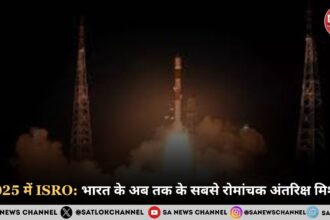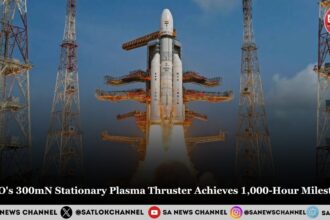Key points regarding India to deploy bodyguard satellites
- Why India is Strengthening Space Security
- The Concept of Bodyguard Satellites
- The Trigger: A Risky Near-Miss in 2024
- India’s Satellite-Protection Project
- Advanced Technologies for Multilayered Defense
- Global Cooperation and Comparisons
- India’s Space Security – Building a Safer Orbit for the Future
- Beyond Science: The Spiritual Wisdom of Saint Rampal Ji Maharaj Ji
- FAQs on India’s Bodyguard Satellites and Space Protection
- India to deploy “bodyguard satellites” for safeguarding critical space assets.
- Plan triggered after a 2024 near-miss between an Indian and foreign satellite.
- Project NETRA and ISRO’s IS4OM to boost space surveillance and debris tracking.
- LiDAR satellites, radars, and telescopes to help detect threats early.
- Cybersecurity, solar storm preparedness, and global cooperation part of multilayered defense.
- The ₹270 billion plan includes nearly 50 surveillance satellites in the coming years.
Why India is Strengthening Space Security
Satellites have become the backbone of modern life from guiding airplanes and ships to powering internet services, financial transactions, weather monitoring, and national security operations. Any threat to these orbiting assets could disrupt critical systems on Earth.
India’s recent decision to plan “bodyguard satellites” comes in response to growing risks in space. The turning point was a near collision in mid-2024 between an Indian Space Research Organisation (ISRO) satellite and a spacecraft from a neighboring country. This close call exposed the vulnerabilities of Indian satellites and highlighted the urgent need for protective measures.
The Concept of Bodyguard Satellites
Bodyguard satellites are specially designed spacecraft that escort high-value satellites, monitoring their surroundings, identifying suspicious maneuvers, and countering possible threats. These guardians act as the first line of defense against:
- Physical threats like space debris traveling at speeds of 28,000 km/h.
- Digital threats including radio jamming, spoofing, and hacking attempts.
- Geopolitical threats where hostile nations might shadow or interfere with satellites.
- Natural threats such as solar storms that can disrupt electronics and orbit stability.
The Trigger: A Risky Near-Miss in 2024
According to reports, the mid-2024 incident involved an ISRO Earth observation satellite orbiting between 500–600 kilometers above Earth. A neighboring nation’s satellite came within just one kilometer of it, unusually close by orbital standards.
Also Read: 6G Technology: Redefining Limits In The Chase For Perfection
Experts suggest this could have been a “show of strength” to demonstrate advanced maneuvering capabilities. While no collision occurred, the event served as a wake-up call, underscoring that India must protect its space assets not just from debris but also from strategic threats.
India’s Satellite-Protection Project
The bodyguard satellite initiative is part of a broader ₹270 billion ($3 billion) project announced by the Indian government. The plan includes deploying around 50 surveillance satellites in the coming years, aimed at enhancing situational awareness in orbit.
India’s efforts also build on its past experience. During armed hostilities with Pakistan in May 2024, ISRO played a vital role by providing real-time Earth observation and communication support, with more than 400 scientists working around the clock. Officials confirmed that space assets were critical in supporting India’s defense operations.
Advanced Technologies for Multilayered Defense
ISRO’s IS4OM (System for Safe and Sustainable Operations Management)
Based in Bengaluru, this center tracks satellites and space debris, issues collision warnings, and coordinates evasive maneuvers.
Project NETRA
Launched to expand India’s space situational awareness, Project NETRA includes advanced radars and telescopes. A Multi-Object Tracking Radar at Sriharikota is already operational, with more such facilities planned nationwide.
LiDAR Satellites
India is exploring Light Detection and Ranging (LiDAR) satellites that can quickly identify threats and provide enough time for repositioning.
Cybersecurity Measures
India’s CERT-In has introduced strict guidelines for satellite operators, including encryption, network segmentation, and routine security audits to safeguard space-based systems.
Solar Storm Preparedness
With the Aditya-L1 mission now monitoring solar activity, India can receive early warnings about solar storms to protect satellites from radiation damage.
Global Cooperation and Comparisons
India is not working in isolation. It actively participates in global initiatives like the UN Committee on the Peaceful Uses of Outer Space (COPUOS) and the Inter-Agency Debris Coordination Committee (IADC). These organizations promote responsible space practices and debris management.
Other nations have also developed strong space protection systems:
The United States: Operates the Space Fence radar, Protected Tactical Waveform for secure communications, and encrypted GPS M-code.
Europe: Uses EU Space Surveillance and Tracking (EUSST) and Galileo OSNMA for authenticated navigation messages.
NATO: Recognizes space as an operational domain, focusing on joint protection strategies.
India’s entry into this elite group signals its determination to become a leading power in space security.
India’s Space Security – Building a Safer Orbit for the Future
India’s decision to create “bodyguard satellites” is more than just a technological advancement; it is a strategic move to protect national security, communication systems, and economic lifelines tied to space. By combining surveillance, LiDAR technology, cybersecurity, and global cooperation, New Delhi is ensuring that its satellites remain secure in an increasingly contested domain.
As the world edges closer to potential conflicts in orbit, India’s layered approach could set a new benchmark in satellite protection safeguarding not only its assets but also contributing to global space sustainability.
Beyond Science: The Spiritual Wisdom of Saint Rampal Ji Maharaj Ji
No matter how far humanity advances into space, one truth remains unshaken: all science, technology, and knowledge are ultimately the gifts of the Supreme God. Satellites, rockets, and the vast revolutions of technology are possible only because the Creator blessed His children with intelligence and resources.
Along with professional work, we must embrace the higher purpose of life: true devotion. Saint Rampal Ji Maharaj Ji, the present Tatvadarshi Saint, explains this in His discourses (spiritual Satsangs). He reveals Tatvgyan (true spiritual knowledge) and teaches that only the Complete God, the nourisher of all universes, has created everything and continues to provide for His children.
God has chosen this very time in Kalyug to liberate His souls. If we reflect deeply, just a few decades ago science was limited, but today a great revolution has taken place in technology. This is not by chance but by God’s design so that His children can easily access His divine knowledge from their homes and prepare themselves to return to their eternal abode, Satlok.
To learn more about this eternal truth and the path to liberation, visit www.jagatgururampalji.org
FAQs on India’s Bodyguard Satellites and Space Protection
Q1. What are India’s bodyguard satellites?
Bodyguard satellites are specially designed spacecraft that escort and protect high-value Indian satellites. They monitor close approaches, detect threats like space debris or hostile maneuvers, and ensure communication and defense satellites remain secure in orbit.
Q2. Why is India planning bodyguard satellites now?
India decided to develop bodyguard satellites after a near-miss in 2024, when a foreign satellite came dangerously close to an ISRO Earth observation satellite. This incident exposed vulnerabilities and highlighted the urgent need to safeguard national space assets.
Q3. How will ISRO protect satellites from threats in space?
ISRO is strengthening space security through multiple layers IS4OM for debris tracking, Project NETRA for space surveillance, LiDAR satellites for early threat detection, strong cybersecurity measures, and solar storm preparedness via the Aditya-L1 mission.
Q4. How does India’s satellite protection compare with other countries?
India is joining global leaders like the US and Europe in space security. The US has systems like Space Fence and encrypted GPS M-code, while Europe uses EUSST and Galileo OSNMA. India’s bodyguard satellites combined with ISRO’s tracking projects make it a strong contender in global space defense.
Q5. What is the budget and scale of India’s space protection project?
India’s government has announced a ₹270 billion ($3 billion) plan to launch around 50 surveillance satellites in the coming years. This large-scale project will create a multilayered defense system to secure communication, navigation, and defense satellites against growing threats in space.









